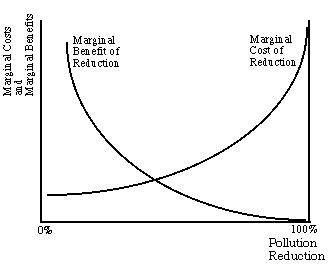
Figure 1
- the amount at which average benefit is equal to average cost.
- 100 percent, since that maximizes the gains from pollution control.
- zero, since pollution controls reduce profits.
- the amount at which the marginal benefits equal the marginal costs.
- indeterminate without additional information about the type of
pollution.
- shift the marginal cost curve rightward, increasing the optimal level of pollution control.
- shift the marginal benefit curve leftward, decreasing the optimal level of pollution control.
- shift both the marginal benefit curve and the marginal cost curve rightward, increasing the optimal level of pollution control.
- shift the marginal benefit curve rightward, increasing the optimal level of pollution control.
- shift both the marginal benefit curve and the marginal cost curve
leftward, decreasing the optimal level of pollution control.
- shifts the marginal cost curve rightward, increasing the optimal level of pollution control.
- shifts the marginal cost curve leftward, decreasing the optimal level of pollution control.
- shifts both the marginal benefit curve and the marginal cost curve rightward, increasing the optimal level of pollution control.
- shifts the marginal benefit curve rightward, increasing the optimal level of pollution control.
- shifts both the marginal benefit curve and the marginal cost curve
leftward, decreasing the optimal level of pollution control.
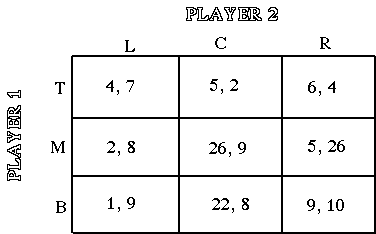
Figure 2
- TL, BR
- MC, BR
- ML, TR
- TR, MR, BC
- There are no pure strategy Nash equilibria.
- M for 1, R for 2
- M for 1, L for 2
- B for 1, no dominant strategies for 2
- R for 2, no dominant strategies for 1
- There are no dominant strategies.
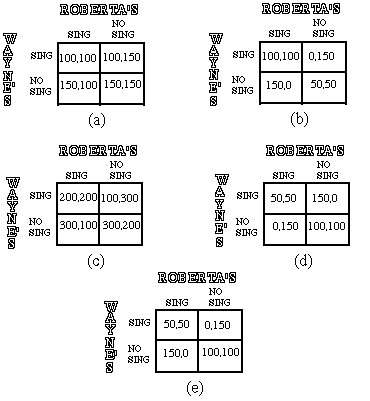 Answer to Question 6
Answer to Question 6
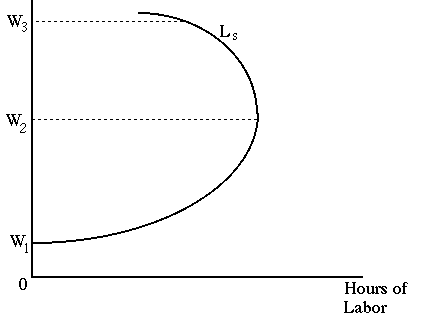
Figure 3
- from 0 to W1 the income effect of a wage increase dominates the substitution effect.
- from W2 to W3 the substitution effect of a wage increase dominates the income effect.
- at wages below W2, there is no substitution effect from a wage increase .
- from W1 to W2 the substitution effect of a wage increase dominates the income effect.
- from W1 to W2the income effect of a wage increase dominates the substitution
effect.
- laying off workers since it takes fewer workers to produce the same amount of output.
- hiring more workers since increased productivity is equivalent to reduced production costs.
- laying off workers since it will now need more capital to go with the healthier workers.
- keep employment the same and enjoy greater profits.
- it all depends on the supply elasticity of labor's marginal demand.
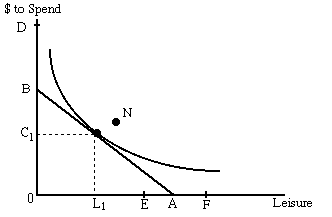
Figure 4
- shifting the budget line to the right.
- drawing a new budget line from points E to D.
- drawing a new budget line from points A to D.
- drawing a new budget line from points B to F.
- shifting the isoquants schedule away from the origin.
- she is being paid too much.
- the opportunity cost of leisure has fallen for her.
- consumer goods are inferior goods for her.
- she is on the backward bending portion of her labor supply curve.
- the income effect of her wage increase is dominated by the substitution
effect.
- surplus and price will increase.
- shortage and price will decrease.
- surplus and price will decrease.
- shortage and price will increase.
- no surplus or shortage as this is the equilibrium price.
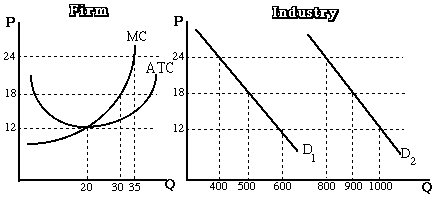
Figure 5
- Price = 12 and Quantity = 20
- Price = 18 and Quantity = 30
- Price = 24 and Quantity = 35
- Price is below 12 and Quantity is below 20
- Price is above 24 and Quantity is above 35.
- 20.
- 25.
- 30.
- 35.
- 40.
- Price = 12 and Quantity = 20
- Price = 18 and Quantity = 30
- Price = 24 and Quantity = 35
- Price is below 12 and Quantity is below 20
- Price is above 24 and Quantity is above 35.
- 20.
- 30.
- 40.
- 50.
- 60.
The next 3 questions concern a market for which the demand function is given by Q = 90 - 10P. You may find it helpful to sketch graphs.
- 30
- 45
- 50
- 65
- 90
- 105
- 115
- 125
- 135
- 180
- 90
- 180
- 270
- 360
- 405
- higher quantity, lower price.
- lower quantity, lower price.
- indeterminate change in quantity, but higher price.
- indeterminate change in quantity, but lower price.
- higher quantity, but indeterminate change in price.

Figure 6
- losses equal DCBE.
- total variable costs equal area DPAE.
- profits are at their maximum value and equal CPAB.
- economic inefficiency occurs because price exceeds average cost.
- profit is zero.
- CPAB.
- DCBE.
- 0PAQ*.
- DPAE.
- DPBE.
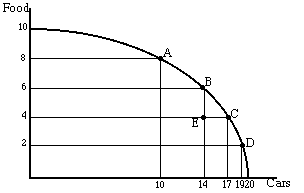
Figure 7
- 2.
- 3.
- 10.
- 14.
- 17.
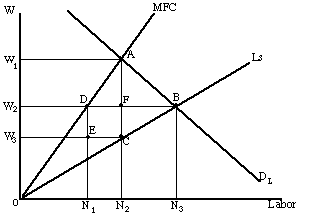
Figure 8
- Wage = W2 and Labor = N3
- Wage = W1 and Labor = N2
- Wage = W3 and Labor = N3
- Wage = W3 and Labor = N2
- Wage = W2 and Labor = N1
- W1 A F W2.
- A C B.
- A F B.
- W2 B C W3.
- W1 A B W2.
- W2 B LS
- W2 D A
- W3 E C B LS
- 0 D F A MFC.
- W3 E D F B LS .
- Reduce hiring to N1 and keep the wage at W3
- Increase hiring to N3 and increase the wage to W2
- Increase hiring to N3and keep the wage at W1
- Reduce hiring to N3 and reduce the wage to W3
- Increase hiring to N2 and increase the wage to W2
- is always the same as setting price equal to marginal revenue.
- is explicitly made legal by the Sherman Antitrust Act.
- permits firms to achieve allocative efficiency.
- enables firms to agree on reduced output.
- pushes out the production possibilities frontier.
- $10,000/1.1.
- an infinite amount since it will yield an infinite stream of payments.
- to increase when the price of farm products falls.
- $100,000.
- $10,000/(1.119).
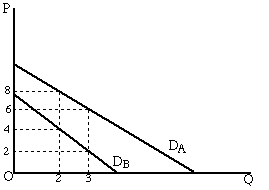
Figure 10
- $8.
- $4.
- $12.
- $6.
- $2.
- between $6 and $4.01.
- between $4 and $2.01.
- between $14 and $8.01.
- between $3 and $2.01.
- between $12 and $8.01.
- -$65,000
- -$2,000
- +$5,000
- +$48,000
- +$30,000
- increasing returns to scale.
- decreasing returns to scale.
- constant returns to scale.
- diseconomies of scale.
- law of diminishing returns.
| Table 1 | |||
|---|---|---|---|
| Income | Quantity Demanded of X | Quantity Demanded of Y | Quantity Demanded of Z |
| 1000 | 125 | 70 | 4 |
| 2000 | 200 | 55 | 9 |
- good X is inferior, good Y is normal, and good Z is inferior.
- good X is normal, good Y is inferior, and good Z is normal.
- good X is normal, good Y is normal, and good Z is inferior.
- good X is inferior, good Y is normal, and good Z is normal.
- good X is inferior, good Y is inferior, and good Z is normal.
- good X is an necessity and good Y is a luxury.
- good Y is an necessity and good Z is a luxury.
- good Z is an necessity and good X is a luxury.
- good X is an necessity and good Z is a luxury.
- good Z is an necessity and good Y is a luxury.
- A decrease in the price of a good that is a substitute for widgets.
- An increase in the price of a good that is a complement for widgets.
- A decrease in consumer's incomes if widgets are an inferior good.
- A change in consumer's expectations leading them to believe that the price of widgets will fall in the future.
- Any change in the demand for the product of a firm that hires
labor in competitive factor markets will lead to a change both
in numbers employed and in the wage.
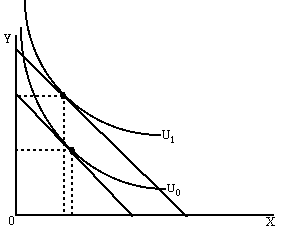
Figure 11
- X is an inferior good and Y is an inferior good.
- X is a normal good and Y is an normal good.
- X is a luxury good and Y is a normal good.
- X is an inferior good and Y is a normal good.
- X is a luxury good and Y is an inferior good.
| Table 2 | |
|---|---|
| Workers | Total Output per Week |
| 1 | 100 |
| 2 | 250 |
| 3 | 350 |
| 4 | 425 |
| 5 | 475 |
| 6 | 500 |
| 7 | 510 |
- $100.
- $1,000.
- $250.
- $700.
- $350.
- 425.
- 500.
- 350.
- 475.
- 250.
- the firm produces a product with many close substitutes.
- a production process in which it is easy to substitute capital for labor.
- a production process in which labor costs are a small fraction of total costs.
- a production process in which adding more labor causes marginal product to fall only slightly.
- a production process in which it is easy to substitute labor for capital.
- Wages of cotton sock workers will increase, and the number hired will increase.
- Wages of cotton sock workers will increase but the change in the number hired will be indeterminate.
- Change in the wages of cotton sock workers will be indeterminate but the number hired will fall.
- Wages of cotton sock workers will fall, and the number hired will increase.
- Change in the wages of cotton sock workers will be indeterminate but the number hired will increase.
- An increase in the number of potato chip bag stuffers hired and an increase in wages paid to potato chip stuffers.
- An increase in the number of potato chip bag stuffers hired and a decrease in wages paid to potato chip stuffers.
- No change in the number of potato chip bag stuffers hired and a decrease in wages paid to potato chip stuffers.
- A decrease in the number of potato chip bag stuffers hired and an increase in wages paid to potato chip stuffers.
- A decrease in the number of potato chip bag stuffers hired and
a decrease in wages paid to potato chip stuffers.
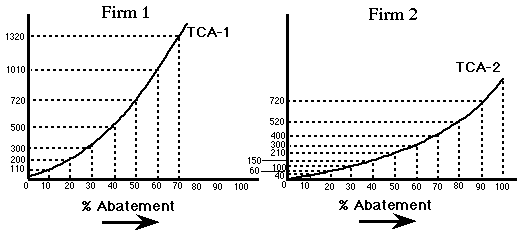
Figure 12
- 700
- 2060
- 510
- 720
- 930
- 720 for Firm 1, 210 for Firm 2
- 144 for Firm 1, 42 for Firm 2
- 220 for Firm 1, 60 for Firm 2
- 1220 for Firm 1, 360 for Firm 2
- 122 for Firm 1, 36 for Firm 2
- 230
- 130
- 600
- 110
- 400
- they force employers to hire workers at wages higher than their marginal physical product.
- they force employers to hire workers at wages higher than their marginal revenue product.
- they always force employers to hire workers at wages below their marginal product.
- when they are effective, they reduce employment.
- they artificially reduce the hiring costs of the firm.